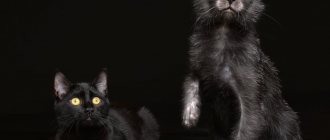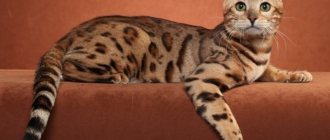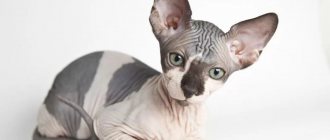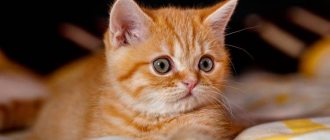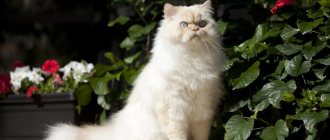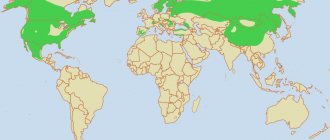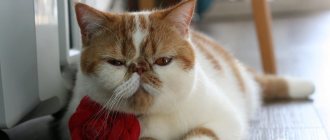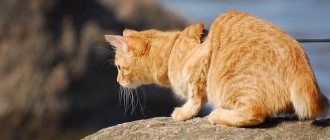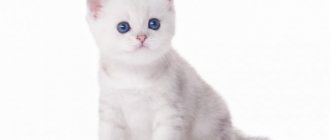Korat cats are beautiful, graceful and surrounded by an aura of mystery. Korats are a very rare and valuable animal; they are also called Thai cats of happiness. A rich silver coat, eyes glowing with diamonds, and a heart-shaped muzzle made this cat famous throughout the world.
Beauties are presented as gifts and placed in homes to attract good luck and prosperity. There are few representatives of this breed at the moment, which makes them one of the most desirable for acquisition.
History of the origin of the breed
Gray kittens were first presented at a cat club show in Great Britain in 1896 under the name Siamese cat (the early name of Thailand was Siam). But the new product did not arouse interest.
The next attempt to popularize the breed was in the 50s of the 20th century. A couple of Korats were brought to America in 1959, they served as material for breeding and distribution. As a separate breed, the Corat was recognized until 1965 by almost all felinological organizations. Cats came from the States to England in 1972. This time they were looked at differently, with interest and respect. In 1982, the breed was officially recognized by FIFE and representatives of the breed, although in small numbers, began to travel around the world.
Their largest population is in the USA, where there are very strict requirements for issuing a pedigree for this cat breed. In addition to America, they are bred in Australia, Britain, Canada, New Zealand and South Africa. Exhibition animals must have documented evidence that their direct ancestors came from Thailand. In their homeland, Korat cats are considered a sacred animal that cannot be traded or sold.
They are respectfully called “si-souvat”, which means “the one who brings happiness.” The Korat cat can only be given as a gift!
And if you give such a cat to newlyweds for their wedding, then love, happiness and prosperity will always reign in their family. Korat cats have always been an integral part of secular and religious rituals in Thailand. To this day they are considered a national treasure. Unfortunately, even here in their homeland, their number is very small, and their export is limited by law.
Video review about Korat cats:
Breed description and standards
Korat cats are distinguished by a graceful, strong body, without excessive massiveness. All lines are smooth and graceful, and large round green eyes give them an alert and expressive appearance. These cats, both in appearance and in life, are always ready for action. If you pick up a cat, it turns out to be noticeably heavier than expected.
Head and muzzle
When viewed from the front and above, the head is shaped like a heart with a prominent brow and soft lines on either side of the muzzle down to the level of the chin. The pinch is weakly expressed. Korats have a “lionlike” nose, with a slight convexity in front of the earlobe. Well developed cheeks and chin. Korats are characterized by high-set, large ears that are rounded at the top and wide at the base. The outer part of the shell is covered with thick hair. The eyes are prominent, widely set and round. Only bright green or amber colors are allowed. The shade is fully formed by 2-4 years. When Korat cats have open eyes, they are wide, and when they close them, their eyes take on an “Asian slant.”
Body
The body is of medium size, refined and graceful with well-developed muscles. The chest is wide, as is the space between the front legs. The back is smoothly arched, and the legs are proportional to the body and are characterized by medium length and muscularity. Cats' paws are oval-shaped. The tail is thick at the base, of medium length and tapers to the tip. Invisible breaks are allowed by the standard.
Coat and color
The coat is short, thin and soft, without undercoat. “Cracks” may form on the back during movement. The shiny coat fits tightly to the body. Externally, Korats are a bit like a Burmese blue cat, and according to genetic data, they resemble an Oriental blue cat. The coat color of Korat cats is exclusively blue with a silver tint, which appears due to slightly lightened tips. In the literature this color is called "solid ticked silver blue". The skin of the nose, lips and paw pads is dark blue or lavender. Their offspring have exactly the same color as their parents.
Russian Blue and Korat: main differences
The breeds are very similar in appearance, but there are still a number of differences that can sometimes only be seen by a specialist:
- Different head shapes. The Russian Blue has a pointed muzzle, while the Korat has a heart-shaped muzzle;
- With the same size, Korats are heavier, stockier and denser in build;
- The body of the Russian Blue is elongated, while that of the Korat is more rounded, due to the somewhat hunched line of the back and general crookedness;
- The Korat's eyes are often golden in color, while those of the Russian Blue are green;
- The Russian Blue has a double textured coat, while the Korats have a single coat that lies close to the body;
- The color of the Korat's coat is darker, closer to steel and has more silver;
- The Korat's ears are rounded, while the Russian Blue's are slightly pointed.
Character and temperament
Korat cats have a wonderful character, they are gentle and charming, they are strongly attached to those from whom they feel love and affection and are very bored if these people are not with them for a long time. This is a very loyal cat breed that can give him a sea of love and affection.
Korats are inquisitive and highly intelligent cats, they are energetic and moderately active.
Koraths have a cheerful disposition, they are sociable and observant and nothing can pass unnoticed by their eyes. Despite the fact that Korat cats are not capricious and loud, they have a good range of sounds, and always manage to explain their needs to their owners. Owners of cats of this breed say that the expressive face of cats, their interesting and intelligent look will do everything to clearly tell what exactly they need.
Features of behavior
These are affectionate, gentle, simply charming cats, they sincerely love their owners, and are sad when separated from them. They demonstrate their love and devotion every day. Quite smart, they are interested in everything: nothing escapes their attention. Active, but not very mobile. They are sociable, love company, are cheerful, most of all they need the attention of their beloved owners, they love to climb onto their laps and enjoy caresses.
They are talkative, and they know how to choose the right intonation and convey the meaning to the listener. Those who have had the good fortune to keep a Korat at home claim that speech is not always important - a Korat has everything written on its face, you can always guess what the cat wants to tell you.
Sociable Korats have difficulty withstanding loneliness, so extremely busy people should not have cats of this breed.
Maintenance and care
Korats are ideal cats for keeping in an apartment or in a house without free range. By temperament they are calm and clean, and due to the absence of undercoat they practically do not shed.
Caring for a Korat is not difficult, and cats themselves do an excellent job of personal hygiene. Their fur is short, without undercoat, it never gets into tangles, so you can brush it only once a week. You should not bathe your pet unless necessary. From frequent water procedures, the hair loses its protection, and the skin dries out, which affects its appearance. Periodically, they clean the ears and wash the eyes, but not on a schedule, but if necessary. Give your cats your love, sit them on your lap, stroke them - they will be grateful to you for it.
I read on forums that Korats are quite difficult to show at exhibitions. This is true?
Yes and no. Korats are always very vocal in "speaking their minds" in the show ring - both good and bad. Relatively calm and not very talkative at home, Korats in the show ring begin to comment on everything they feel: “don’t lift me up too high,” “keep my paws on the ground,” “give me a toy,” “put me back in the cage!” , “take me home!” etc.
When playing a Korat with a toy, judges sometimes need to be careful, especially when the cat is “wound up.” At one show, a judge was playing with a shiny toy with a Korat when she accidentally dropped it and it flew into the audience. And the Korat is right behind her! Once the toy was returned to the judge, the korat immediately returned to the table - a perfect example of the "get the toy at any cost" mentality!
Korats do not like (and will not tolerate) being lifted into the air in the judge's ring. They prefer to either keep their hind legs on the table or feel secure when they are held. In addition, the cat cannot be stretched like an Oriental or Siamese, since the Korat has a semi-cobby body type - the average "stocky" cat. And finally, you cannot fix your head and twist it in different directions. If a Korath feels that his head is being forcibly held, he may panic. This breed is extremely responsive to gentle touch.
Diet
Korat kittens, one month old, are very dependent on their mother and require exclusively mother's milk. Then you need to gradually introduce additional nutrition in the form of low-fat milk and pureed cottage cheese. You can’t feed your cat cow’s milk, just like you can’t introduce low-quality industrial food into your cat’s diet.
It is necessary to diversify the diet starting from 2.5-3 months of age. His food should contain a sufficient amount of protein. For this, sliced raw meat other than pork is usually used. Pork Korat is contraindicated even in adulthood, it causes stomach upset, liver and pancreas damage. An adult cat is already allowed to be fed dry food of at least premium quality.
Possible problems
Like any living beings, Korats have their own characteristics in character and physiology.
- The animal is very jealous and has a strong attachment to its owner. There is no need to have a Korat in the vicinity of dogs or parrots.
- Cats do not tolerate harsh sounds, constant noise and crowds. It is better not to have them if you have small children.
- Indigenous Thais are not adapted to living conditions in cold latitudes. You will have to carefully monitor the health of the animal, avoid hypothermia, drafts, and dress it after washing.
Wool
The animal of this breed does not have an undercoat, and the main coat is of medium length. No tangles are formed and the wool does not fall off. Cats are perfectly capable of grooming their own fur. The owner requires infrequent brushing, once a week. It is better to accustom the kitten from childhood, then he will quickly get used to the procedure.
Combing should be done with a special brush with natural bristles. It is possible to use a fine comb; this will reveal the presence of parasites and evenly distribute sebum over the entire surface of the hairs.
There is no urgent need for bathing, because they are susceptible to colds. You can bathe once every six months or before exhibitions, significant events, or photo shoots.
Nutrition
From the start of life, kittens must be fed mother's milk for at least a month. After a month, the diet gradually expands to include fermented milk products. Kefir and cottage cheese are gradually introduced, the reaction is monitored. If there is no negative reaction, the portions are increased.
After 3 months of life, the kitten’s body needs protein. You need to gradually introduce meat in small portions. It is advisable to use low-fat varieties:
Make sure your adult cat has enough protein in her diet. Meat - at least half of the total food. Raw meat contains the taurine necessary for corate (an important element for vision and the nervous system). Pork should not be present in the diet, as it causes disturbances in the gastrointestinal tract. Meat must also be thermally treated or at least scalded with boiling water for disinfection. New foods are introduced into the diet gradually, monitoring the reaction.
It is important to ensure drinking regime, it should be boiled or distilled water.
Feeding on ready-made food, preferably canned, premium food for purebred cats is encouraged. You can see our rating of wet food here. But if you want to prepare your pet’s food yourself, it is important to ensure the availability of the following products:
- lean meat (at least half of the diet);
- fish – weekly, 1 time;
- by-products containing cartilage;
- dairy products;
- vegetables;
- cereals;
- chicken eggs (once a week).
Health
The Korat breed is characterized as healthy and today there are only 2 hereditary diseases - atelosteogenesis (a hereditary disease characterized by incomplete, impaired bone formation) of the first and second types. Unfortunately, both types of the disease are fatal to cats. Their manifestation is dictated by genetic mutation.
In this case, the lethal outcome of cats in the event of the disease is observed only if they inherit defective genes from both parents. In the event that genes are inherited from only one parent, the cat will only be a carrier of defective genes and will not be in any danger. Korat cats, no less than others, need all veterinary preventive measures. They need to be vaccinated according to schedule and regularly get rid of external and internal parasites. Be sure to monitor the quality of food and the purity of drinking water. With proper care and maintenance, the cat will delight the owner with its health and excellent mood for a long time.
Average life expectancy is 13-14 years.
How to choose a kitten
Choosing a Korat kitten should begin with setting the purpose of its acquisition. This is a rare breed; most Korats are bought for further breeding or an exhibition career. Taking an animal “for yourself” is an expensive purchase, but precedents still happen.
If the purpose of the purchase is participation in exhibitions or breeding, then the first thing you need to focus on is the documents for the kitten. Study the Korat's pedigree, be sure to meet the baby's parents, and at least look at the photos of the parents' Korats. A kitten without documents automatically becomes unsuitable for such purposes from the point of view of specialists, although it will cost much less.
If you want your Korat kitten to take prizes in the future, study the pedigree. If there were exhibition winners in the pet’s family, the cat’s chances of a future victory automatically increase.
After you are sure that everything is in order with the documentation, you need to examine the kitten itself. Pay attention to such nuances as:
- Stomach. The kitten's tummy should not look like a ball. Bloating is the first sign of possible gastritis or other gastrointestinal diseases.
- Mouth. The optimal color for a kitten's mouth is pink. A Korat kitten’s mouth should also not stink. Any deviation in color and the presence of an unpleasant odor indicate health problems.
- Anal hole. The area under the ponytail should be clean and dry. Crumpled hair around the anus indicates that the baby is suffering from diarrhea.
- Body condition. The baby's skin should be completely covered with hair without any bald spots. Feel the kitten; any tumors and swellings are an alarming signal.
- General state. It is better not to buy a lethargic kitten. But there is one nuance here. If you see that the kitten is generally healthy and suitable for you, but is acting lethargic, wait a little. The baby may have recently woken up or eaten a heavy meal, but lethargic behavior of the animal after eating and sleeping is normal.
Don't forget about the character of the animal. The character of a Korat can be noticed immediately by observing how the baby behaves. Take a pet that is moderately active, not very lethargic, but not hyperactive either.
First mating of a Korat cat
You can breed a Korat cat only when it reaches the age of 10 months, not earlier. Before the first mating, the cat must go through several heats - 2-3. It is not recommended to wait more than three heats, and if the cat is often in heat, then you can breed her a little earlier than usual.
Prepare the animal for mating:
- carry out deworming;
- undergo a medical examination;
- Vaccinate your animal against infections.
Korats are very fertile, with an average litter of 4-5 kittens, but sometimes a cat gives birth to up to 9 babies. They all appear with gray fur and yellow or pale green eyes, which become brighter with age.
Korat cat: kitten price
Since you can only buy a Korat kitten abroad or, if you are lucky, from a rare breeder who transports Korats, you should understand that the price of a Korat, by definition, cannot be low. Price may vary depending on factors such as:
- Class;
- pedigree;
- delivery location, etc.
If you're lucky, you can buy a purebred kitten for a very reasonable price. But with the condition of his castration or sterilization, in order to avoid subsequent reproduction. You can also buy an aged Korat inexpensively, if this option is acceptable to you. In any case, breeders are people too and you can always agree on the price and other conditions for purchasing an animal. If we take the average value as a basis, then it is worth considering that although the price of kittens varies depending on the country, as a rule, in any case it does not fall below $500.
Considering the above, you should be wary of offers to buy a Korat kitten through a message board on the Internet, and even more so at the bird market.
Where can I buy
You can buy a kitten with a pedigree in Thailand, Europe or North America. In Russia, unfortunately, there are no nurseries with Korats. To buy such cats in Russia or Ukraine, you will have to turn to private owners. To the question, “how much does a kitten of this breed cost?” You can answer in two words: “very much.” Even without a pedigree, the price in Russia is about 30 thousand rubles, the price in Ukraine is about 10 thousand hryvnia. Those whose income is above average can afford a Korat even with a pedigree, and people who do not have such funds can recommend the Russian Blue breed.
